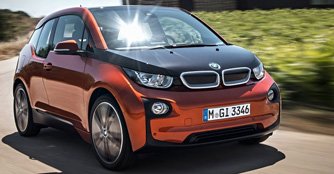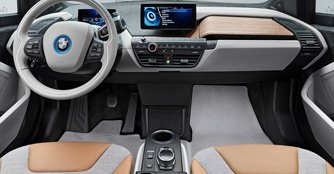BMW unveils production ready i3
30 Jul 2013|4,172 views
The BMW i3's innovative vehicle concept, including a passenger compartment made from carbon fibre reinforced plastic (CFRP), combines lightness, stability and safety with extraordinary spaciousness. Meanwhile, the driver assistance systems and mobility services from BMW Connected Drive and the 360° ELECTRIC services - turn zero-emission urban mobility into a compelling everyday driving experience.

The motor sources its energy from lithium-ion storage cells integrated into the car's underfloor section. The BMW i3 is capable of completing the benchmark century sprint in a respectable 7.2 seconds.
The battery gives the car a range between 130km and 160km when fully charged from a conventional domestic power socket, BMW i Wallbox or a public charging station. The electric motor, power electronics and high voltage lithium-ion battery have been developed independently by the BMW Group under its BMW eDrive programme.
If desired, the BMW i3 is also available with a range-extending 650cc two-cylinder petrol engine, which maintains the charge of the lithium-ion battery at a constant level while on the move. The power unit develops 34bhp and increases the car's maximum range to around 300km.
The high-voltage battery consists of eight modules - each with 12 individual cells - which together produce a rated voltage of 360 volts and generate approximately 22 kilowatt hours of energy. The battery warranty is valid for eight years or 100,000km. The battery pack is mounted flat in the Drive module and weighs approximately 230 kilograms.

Different versions of the BMW i Wallbox are available, depending on the country, to reflect the current strength and voltage in the individual markets.
When the BMW i3 is plugged into a modern public fast-charging station (50 kW), it only takes about 30 minutes for the battery to reach 80 percent capacity.
A body measuring 3,999mm by 1,775mm by 1,578mm (L x W x H) gives the BMW i3 distinctive proportions whose dynamism and compactness underline the car's agility in urban use.
The short overhangs of the BMW i3 are also a clear pointer to its nimble driving characteristics. Large glass surfaces flood the i3 with a compelling lightness and, together with its visible carbon structures, provide a window into the car's low-weight design.
Like the RX-8, 'coach' doors, coupled with the absence of B-pillars and the centre tunnel normally found in conventional vehicles, form the basis for the unusually high degree of spaciousness and freedom of movement inside the BMW i3.
A slightly raised seating position optimises the driver's view while the gear selector and start/stop switch share a control element projecting from the steering column. Both the instrument cluster and the iDrive operating system's Control Display (6.5 inch or 8.8 inch) come in free-standing display form.
Standard equipment includes the iDrive system, air conditioning, stationary climate control and a variable luggage compartment among other novelties. Additional options include a choice of navigation systems, Adaptive LED Headlights, an electrically operated glass roof and a host of BMW ConnectedDrive features among others.
The BMW i3's innovative vehicle concept, including a passenger compartment made from carbon fibre reinforced plastic (CFRP), combines lightness, stability and safety with extraordinary spaciousness. Meanwhile, the driver assistance systems and mobility services from BMW Connected Drive and the 360° ELECTRIC services - turn zero-emission urban mobility into a compelling everyday driving experience.
The electric motor powering the BMW i3 generates a maximum output of 170bhp and peak torque of 250Nm and flows to the rear wheels via a single-speed transmission.
The motor sources its energy from lithium-ion storage cells integrated into the car's underfloor section. The BMW i3 is capable of completing the benchmark century sprint in a respectable 7.2 seconds.
The battery gives the car a range between 130km and 160km when fully charged from a conventional domestic power socket, BMW i Wallbox or a public charging station. The electric motor, power electronics and high voltage lithium-ion battery have been developed independently by the BMW Group under its BMW eDrive programme.
If desired, the BMW i3 is also available with a range-extending 650cc two-cylinder petrol engine, which maintains the charge of the lithium-ion battery at a constant level while on the move. The power unit develops 34bhp and increases the car's maximum range to around 300km.
The high-voltage battery consists of eight modules - each with 12 individual cells - which together produce a rated voltage of 360 volts and generate approximately 22 kilowatt hours of energy. The battery warranty is valid for eight years or 100,000km. The battery pack is mounted flat in the Drive module and weighs approximately 230 kilograms.
Customers can charge their car from a domestic plug socket or have a BMW i Wallbox installed, which uses the maximum current strength available to charge the battery in around six hours.
Different versions of the BMW i Wallbox are available, depending on the country, to reflect the current strength and voltage in the individual markets.
When the BMW i3 is plugged into a modern public fast-charging station (50 kW), it only takes about 30 minutes for the battery to reach 80 percent capacity.
A body measuring 3,999mm by 1,775mm by 1,578mm (L x W x H) gives the BMW i3 distinctive proportions whose dynamism and compactness underline the car's agility in urban use.
The short overhangs of the BMW i3 are also a clear pointer to its nimble driving characteristics. Large glass surfaces flood the i3 with a compelling lightness and, together with its visible carbon structures, provide a window into the car's low-weight design.
Like the RX-8, 'coach' doors, coupled with the absence of B-pillars and the centre tunnel normally found in conventional vehicles, form the basis for the unusually high degree of spaciousness and freedom of movement inside the BMW i3.
A slightly raised seating position optimises the driver's view while the gear selector and start/stop switch share a control element projecting from the steering column. Both the instrument cluster and the iDrive operating system's Control Display (6.5 inch or 8.8 inch) come in free-standing display form.
Standard equipment includes the iDrive system, air conditioning, stationary climate control and a variable luggage compartment among other novelties. Additional options include a choice of navigation systems, Adaptive LED Headlights, an electrically operated glass roof and a host of BMW ConnectedDrive features among others.
Latest COE Prices
October 2025 | 2nd BIDDING
NEXT TENDER: 05 Nov 2025
CAT A$122,000
CAT B$131,889
CAT C$76,801
CAT E$136,000
View Full Results Thank You For Your Subscription.
















































